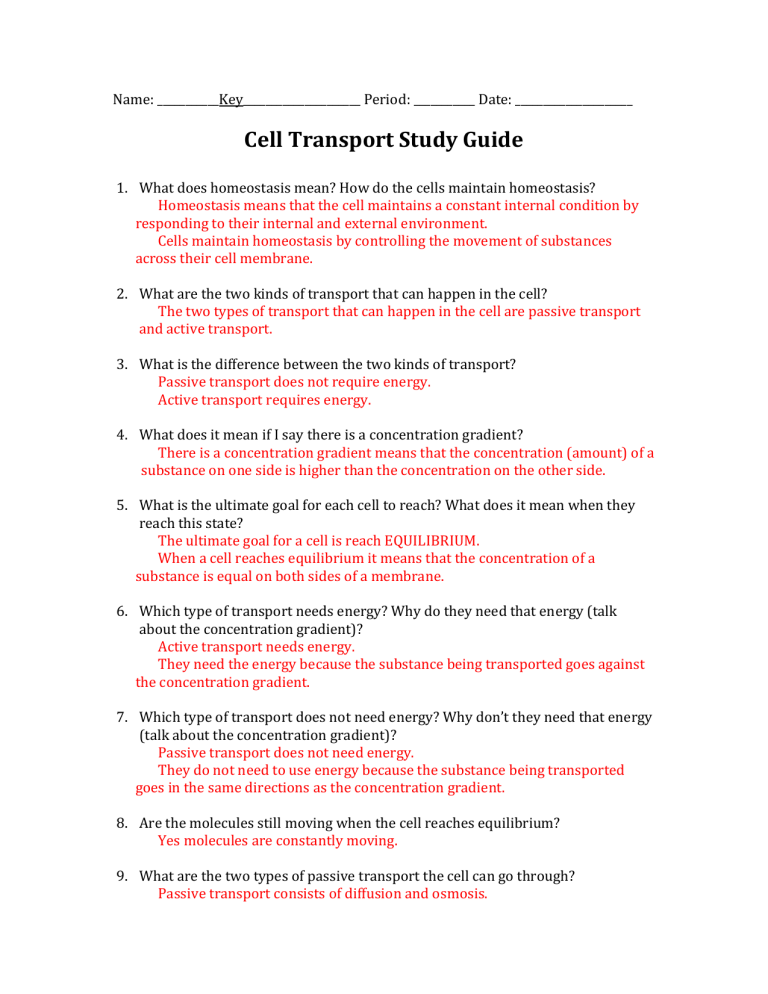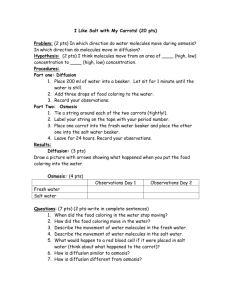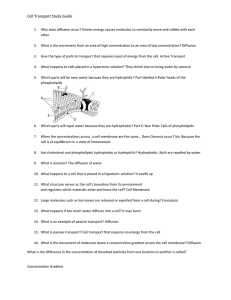cell transport study guide answers

Name: ___________Key_____________________ Period: ___________ Date: _____________________
Cell Transport Study Guide
1.
What does homeostasis mean? How do the cells maintain homeostasis?
Homeostasis means that the cell maintains a constant internal condition by responding to their internal and external environment.
Cells maintain homeostasis by controlling the movement of substances across their cell membrane.
2.
What are the two kinds of transport that can happen in the cell?
The two types of transport that can happen in the cell are passive transport and active transport.
3.
What is the difference between the two kinds of transport?
Passive transport does not require energy.
Active transport requires energy.
4.
What does it mean if I say there is a concentration gradient?
There is a concentration gradient means that the concentration (amount) of a substance on one side is higher than the concentration on the other side.
5.
What is the ultimate goal for each cell to reach? What does it mean when they reach this state?
The ultimate goal for a cell is reach EQUILIBRIUM.
When a cell reaches equilibrium it means that the concentration of a substance is equal on both sides of a membrane.
6.
Which type of transport needs energy? Why do they need that energy (talk about the concentration gradient)?
Active transport needs energy.
They need the energy because the substance being transported goes against the concentration gradient.
7.
Which type of transport does not need energy? Why don’t they need that energy
(talk about the concentration gradient)?
Passive transport does not need energy.
They do not need to use energy because the substance being transported goes in the same directions as the concentration gradient.
8.
Are the molecules still moving when the cell reaches equilibrium?
Yes molecules are constantly moving.
9.
What are the two types of passive transport the cell can go through?
Passive transport consists of diffusion and osmosis.
10.
What is the difference between the two types of passive transport? (mention concentrations)
Diffusion is the movement of molecules from an area of higher concentration to an area of lower concentration.
Osmosis is the movement of water across a selectively permeable membrane.
11.
What is a real world example of diffusion that we discussed?
A real world example would be putting a couple drops of food coloring into a container of water. Once putting the drops in their particles start spreading out in the water until the entire container is the food coloring color and the water and food color reach equilibrium.
12.
What is a real world example of osmosis that we discussed?
Lots of choices. You could mention killing slugs with salt, wooden doors expanding and getting stuck, and carrots in a grocery store.
13.
Why do grocery stores water their carrots? What is the process that is going on?
The water their carrots to keep them hydrated and firm. The carrots are going through osmosis. They are actually in a hypotonic solution because their cells are expands and would burst but cannot because they have a cell wall.
14.
What does the word solvent mean? Give an example along with the definition.
Solvent is a name for a substance that is dissolving a different substance. An example is water.
15.
What does the word solute mean? Give an example along with the definition.
Solute is a name for a substance that is being dissolved by a solvent. An example is salt when in water.
16.
What happens in a hypertonic solution?
In a hypertonic solution a cell could shrink because the solution is leaving the cell.
17.
What happens in a hypotonic solution?
In a hypotonic solution a cell could burst because the solution is entering the cell.
18.
What happens in an isotonic solution?
In an isotonic solution a cell produces no change in cell volume.
19.
This type of passive transport deals with just small molecules not water.
(diffusion or osmosis)
Diffusion
20.
This type of passive transport deals with just water. (diffusion or osmosis)
Osmosis
21.
Do molecule ever stop moving?
No, molecules are constantly in motion.
22.
What does it mean if a cell membrane is semi-permeable to salt?
It means that salt can pass across the membrane but other molecules cannot.
Answer the following questions by looking at the picture below.
Beaker A has a 30% salt concentration (which means that the water amount is
70%). Beaker B has a 50% salt concentration.
23.
What is the water amount in Beaker B?
50%
24.
In which direction will the salt move initially?
The salt will move from Beaker A to Beaker B. Left to right.
25.
Which direction with the water move initially?
The water will move from Beaker B to Beaker A. Right to left.




